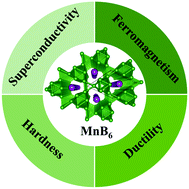Pressure-stabilized MnB6 that exhibits high-temperature ferromagnetism and high ductility at ambient pressure†
Abstract
Metal borides are of significant interest because of their high strength, high melting point, superconductivity and magnetism. Here, a combination of swarm-intelligence structural search and first-principle calculations propose a pressure-stabilized hitherto unknown manganese boride, MnB6, that is recoverable under ambient conditions and exhibits versatile properties. MnB6 contains unique B∞ ribbons along the c-axis, which are linked to each other in the a-b plane by B–B bonds to form open channels filled with Mn atoms. MnB6 is ferromagnetic at its onset energetically stable pressure of 127 GPa and undergoes a transition from magnetic to superconducting at 160 GPa, with an estimated superconducting critical temperature of 15.9 K. Under ambient pressure, MnB6 exhibits increased ferromagnetism with a magnetic moment of 1 μB per Mn atom and a Curie temperature as high as 520 K. Moreover, MnB6 possesses good mechanical properties with an estimated Vickers hardness of 25 GPa and high ductility, which stems from the peculiar structural arrangements in MnB6 driven by the ability of boron to form unusually versatile bonding states.



 Please wait while we load your content...
Please wait while we load your content...